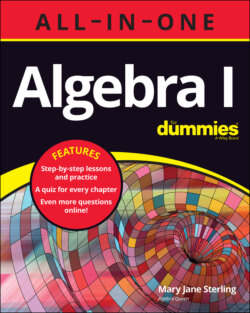Читать книгу Algebra I All-in-One For Dummies - Mary Jane Sterling, Mary Sterling Jane - Страница 68
Identifying Identities
ОглавлениеThe term identity in mathematics is most frequently used in terms of a specific operation. When using addition, the additive identity is the number 0. You can think of it as allowing another number to keep its identity when 0 is added. If you add , the result is 7. The number 7 doesn’t change. When using multiplication, the multiplicative identity is the number 1. When you multiply , the result is 7. Again, the number 7 doesn’t change.
When adding a number and its additive inverse together, you get the additive identity. So . And when multiplying a number and its multiplicative inverse together, you get the multiplicative identity. Multiplying, .
Q. Use an additive identity to change the expression to an expression with only the variable term.
A. The additive inverse of 5 is –5. If you add –5 to the expression, you have . Use the associative property to group the 5 and –5 together: . The sum of a number and its additive inverse is 0, so the expression becomes . Because 0 is the additive identity, .
Q. Use a multiplicative identity to change the expression into an expression without a fraction.
A. Because the term can be written , you can identify the coefficient and work on it to find a multiplicative inverse. The multiplicative inverse of is 9. So multiply both terms by 9.
Notice how the distributive function works for you here!
28 Use an additive identity to change the expression to one with only the variable term.
29 Use an additive identity to change the expression to one with only the variable term.
30 Use a multiplicative identity to change the term –7x to one with only the variable factor.
31 Use a multiplicative identity to change the expression to one with the variable factor having an integer for a coefficient.
